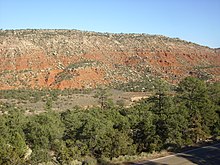Arroyo del Agua Formation
The Arroyo del Agua Formation is a geologic formation in New Mexico. It preserves fossils dating back to the early Permian period.
| Arroyo del Agua Formation Stratigraphic range: early Permian | |
|---|---|
 Mesa Montosa near Arroyo Del Agua, New Mexico | |
| Type | Formation |
| Unit of | Cutler Group |
| Underlies | De Chelly Sandstone, Shinarump Conglomerate |
| Overlies | El Cobre Canyon Formation |
| Thickness | 120 m (390 ft) |
| Lithology | |
| Primary | Siltstone |
| Other | Sandstone |
| Location | |
| Coordinates | 36.1676763°N 106.6495486°W |
| Region | New Mexico |
| Country | United States |
| Type section | |
| Named for | Arroyo Del Agua, New Mexico |
| Named by | Lucas and Krainer |
| Year defined | 2005 |
 Arroyo del Agua Formation (the United States)  Arroyo del Agua Formation (New Mexico) | |
Description
The Arroyo del Agua Formation consists of siliclastic red beds with a total thickness of roughly 120 meters (390 feet). These lie conformably on the El Cobre Canyon Formation and are in turn overlain in most locations by the Shinarump Conglomerate. In a few locations in the southernmost Chama Basin, there is a tongue of De Chelly Sandstone between the Arroyo del Agua and Shinarump.[1]
The formation is 58% siltstone and 34% sandstone, with minor conglomerate and calcrete (each about 4%). The siltstone beds also contain numerous calcrete nodules, and they form thick slopes between thin sandstone sheets. The sandstone sheets themselves are coarse, arkosic, and trough crossbedded. The minor conglomerate beds are mostly composed of intraformational calcrete clasts, but conglomerate beds containing extraformational quartzite clasts are more common in the upper part of the formation. The formation is well exposed in the walls of El Cobre Canyon and in the valley of the Rio Puerco.[1]
The formation superficially resembles the underlying El Cobre Canyon Formation. However, the siltstone beds are more orange in color than the brown beds of the underlying El Cobre Canyon Formation, allowing the two to be easily distinguished. Other distinguishing characteristics include the multistoried sandstone beds of the El Cobre Canyon Formation compared with the thin sandstone sheets of the Arroyo del Agua Formation; the thin silstone beds of the El Cobre Canyon Formation compared with the thick siltstone beds of the Arrroyo del Agua Formation; the greater amount of extraformational conglomerate in the El Cobre Canyon Formation; and the much more calcareous nature of the beds of the El Cobre Canyon Formation compared with the Arroyo del Agua Formation.[1]
The Arroyo del Agua Formation correlates with the upper Abo Formation to the south.[1]
Fossils
Compared with the underlying El Cobre Canyon Formation, the Arroyo del Agua Formation is relatively scarce in age-diagnostic fossils. Only two locations have yielded such fossils, which included a Sphenacodon bone bed high on the eastern wall of El Cobre Canyon and a Seymouria bone bed north of Youngsville on the Rio Puerco. These indicate a late Wolfcampian age.[1]
History of investigation
Although the Cutler Formation in the Chama Basin has been well studied for its fossil fauna since the Macomb expedition of 1858, its lithology was long neglected. Dalton mapped the Permian redbeds of the Chama Basin as Abo Formation in 1928.[2] In 1946, Wood and Northrop mapped the Pennsylvanian-Permian red beds north of latitude 36 degrees as Cutler Formation and south of that latitude as Abo Formation.[3] It was not until 2005 that the lithology of these beds was well enough characterized for it to be raised to group status and divided into the lower El Cobre Canyon Formation and upper Arroyo del Agua Formation by Lucas and Krainer in 2005.[1]
Footnotes
- Lucas and Krainer 2005
- Dalton 1928
- Wood and Northrop 1946
References
- Darton, N. H. (1928). Geologic map of New Mexico. Washington, D.C.: U.S. Geological Survey.
- Langston, W., Jr. (1953). "Permian amphibians from New Mexico". Publications in Geological Sciences. University of California. 29: 349–416.
- Lucas, Spencer G.; Krainer, Karl (2005). "Stratigraphy and correlation of the Permo-Carboniferous Cutler Group, Chama Basin, New Mexico" (PDF). New Mexico Geologic Society Field Conference Series. 56: 145–159. Retrieved 9 July 2020.
- Williston, S.W.; Case, E.C. (1913). "Description of the vertebrate-bearing beds of north-central New Mexico". Carnegie Institution of Washington Publications. 181: 37–59.
- Wood, G.H.; Northrop, S.A. (1946). "Geology of Nacimiento Mountains, San Pedro Mountain, and adjacent plateaus in parts of Sandoval and Rio Arriba Counties, New Mexico". U.S. Geological Survey Oil and Gas Investigations. Preliminary Map OM-57.